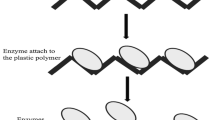Abstract
An enrichment culture method is described for quantifying the activity of hydrocarbon oxidizing bacteria in water and sediments. Application of the procedure indicated that the hydrocarbon oxidizing potential of environmental samples reflects the hydrocarbon burden of the area, the ability of the microflora to utilize hydrocarbons, and that lakes with large aquatic plant communities contain populations of hydrocarbon bacteria comparable to those found in oil-polluted harbors.
Similar content being viewed by others
References
Atlas, R. M., and Bartha, R. 1972. Degradation and mineralization of petroleum in sea water: Limitation by nitrogen and phosphorous.Biotech. Bioeng. 14: 309–318.
Atlas, R. M., and Bartha, R. 1973. Abundance, distribution and oil biodegradation potential of microorganisms in Raritan Bay.Environ. Pollut. 4: 291–300.
Blumer, M. 1968. Oil pollution of the ocean.In:Oil on the Sea. D. Hould, editor. Plenum Press, New York. pp. 5–13.
Bushnell, L. D., and Haas, H. F. 1941. The utilization of certain hydrocarbons by microorganisms.J. Bacteriol. 41: 653–673.
Buswell, J. A., and Jurtshuk, P. 1969. Microbial oxidation of hydrocarbons measured by oxygraphy.Arch. Microbiol. 64: 215–222.
Colwell, R. R., Walker, J. D., and Nelson, J. D. 1973. Microbial ecology and the problem of petroleum degradation in Chesapeake Bay.In: The Microbial Degradation of Oil Pollutants. D. G. Ahearn and S. P. Meyers, editors. Center for Wetland Resources, Louisiana State Univ. Publ. No. LSU-SG-73-01. pp. 185–197.
Davies, J. A., and Hughes, D. E. 1968. The biochemistry and microbiology of crude oil degradation.In:`Field Studies Council Symposium. The Biological Effects of Oil Pollution on Littoral Communities. Carthy and Arthur, editors. Field Studies Council, London, pp. 139–144.
Davis, J. B. 1967.Petroleum Microbiology. Elsevier, New York, 604 pp.
Davis, J. B., and Raymond, R. L. 1961. Oxidation of alkyl substituted cyclic hydrocarbons by aNocardia during growth onn-alkanes.Appl. Microbiol. 9: 383–388.
Floodgate, G. D. 1972. Biodegradation of hydrocarbons in the sea.In:Water Pollution Microbiology. R. Mitchell, editor. Wiley-Interscience, New York. pp. 153–171.
Friede, J., Quire, P., Gholson, R., Gaudy, E., and Gaudy, A. F. 1972. Assessment of biodegradation potential for controlling oil spills on the high seas. Project 4110.1/3.1, Dept. of Transportation. 130 pp.
Gunkel, W. 1968. Bacteriological investigations of oil polluted sediments from the Cornish coast following the Torrey Canyon disaster.In:Field Studies Council Symposium. The Biological Effects of Oil Pollution on Littoral Communities. Carthy and Arthur, editors. Field Studies Council, London, pp. 115–158.
Harrison, M. J., Wright, R. T., and Morita, R. Y. 1971. Method for measuring mineralization in lake sediments.Appl. Microbiol. 21: 698–702.
Jones, J. G. 1968. Methods of studying the effect and metabolism of hydrocarbons in natural environments.In:Field Studies Council Symposium. The Biological Effects of Oil Pollution on Littoral Communities, Carthy and Arthur, editors. Field Studies Council, London, pp. 145–150.
Jones, J. G. 1969. The determination of microbial hydrocarbon metabolism in natural environments.Arch. Microbiol. 67: 397–407.
Jones, J. G., and Edington, M. A. 1968. An ecological survey of hydrocarbonoxidizing micro-organisms.J. Gen. Microbiol. 52: 381–390.
Lamanna, C., and Mallette, M. F. 1965.Basic Bacteriology, 3rd ed. The Williams and Wilkins Co., Baltimore.
Pilpel, N. 1968. The natural fate of oil on the sea.Endeavors 27: 11–13.
Quammen, M., LaRock, P. A., and Calder, J. A. 1973. Environmental effects of pulp mill wastes.In:Proceedings of the Belle Baruch Symposium on Estuarine Microbial Ecology. H. L. Stevenson and R. R. Colwell, editors. Univ. of South Carolina, Columbia, South Carolina. In press.
ZoBell, C. E. 1969. Microbial modification of crude oil in the sea.In:Proceedings of Joint Conference on Prevention and Control of Oil Spills, 1969. American Petroleum Institute, New York. pp. 317–326.
ZoBell, C. E. 1972. Microbial degradation of oil: Present status, problems and perspectives.In: The Microbial Degradation of Oil Pollutants. D. G. Ahearn and S. P. Meyers, editors. Center for Wetland Resources, Louisiana State Univ. Publ. No. LSU-SG-73-01. pp. 3–16.
Author information
Authors and Affiliations
Rights and permissions
About this article
Cite this article
Caparello, D.M., Larock, P.A. A radioisotope assay for the quantification of hydrocarbon biodegradation potential in environmental samples. Microb Ecol 2, 28–42 (1975). https://doi.org/10.1007/BF02010379
Issue Date:
DOI: https://doi.org/10.1007/BF02010379




